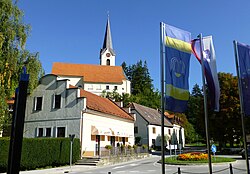Dobrna
 From Wikipedia - Reading time: 7 min
From Wikipedia - Reading time: 7 min
Dobrna | |
|---|---|
 Main square and church | |
| Coordinates: 46°20′17.04″N 15°13′45.41″E / 46.3380667°N 15.2292806°E | |
| Country | |
| Traditional region | Styria |
| Statistical region | Savinja |
| Municipality | Dobrna |
| Area | |
• Total | 1.8 km2 (0.7 sq mi) |
| Elevation | 378.8 m (1,242.8 ft) |
| Population (2020) | |
• Total | 536 |
| • Density | 300/km2 (770/sq mi) |
| [1] | |
Dobrna (pronounced [ˈdoːbəɾna], German: Neuhaus[2]) is a settlement in Slovenia. It is the seat of the Municipality of Dobrna. It is best known for its spa. It lies north of Celje and east of Velenje in an area that is part of the traditional region of Styria. The municipality is now included in the Savinja Statistical Region.[3]
Name
[edit]The name Dobrna is probably derived from the Slavic nickname *Dobrъ, referring to an early inhabitant of the place, therefore originally meaning 'Dobrъ's village'. Another possibility is derivation from the common noun *dǫbrъ 'deciduous or oak forest', in turn derived from *dǫbъ 'deciduous tree, oak', referring to the local vegetation.[4]
Church
[edit]The parish church in the settlement is dedicated to the Assumption of Mary (Slovene: Marijino vnebovzetje) and belongs to the Roman Catholic Diocese of Celje. It dates to the 16th century with 17th-, 18th-, and 19th-century phases of rebuilding.[5]
Spa
[edit]Dobrna is also the site of Terme Dobrna, a spa tracing its history back to 1612. In 1810 and 1811 it was visited by Louis Bonaparte.[6]
References
[edit]- ^ Statistical Office of the Republic of Slovenia
- ^ K. K. Statistischen Central-Commission (1883). Orts-Repertorien der im Oesterreichischen Reichsrathe Vertretenen Königreiche und Lander. IV. Steiermark. Vienna: K. K. Statistischen Central-Commission. p. 12.
- ^ Dobrna municipal site
- ^ Snoj, Marko (2009). Etimološki slovar slovenskih zemljepisnih imen. Ljubljana: Modrijan and Založba ZRC. p. 113.
- ^ Slovenian Ministry of Culture register of national heritage reference number ešd 2942
- ^ "Zgodovina | Terme Dobrna". terme-dobrna.si. Retrieved 2022-12-24.
External links
[edit]
 KSF
KSF

